What is ProQuest?
Many college classes require students to do "research" - that is to find information about something. One of the quickest and easiest ways to do this is to find articles from "periodicals." "Periodicals" is the term used by schools and libraries when referring to magazines, journals, and newspapers. Articles are usually short, often easy to find, and very current. A popular way to find articles is to search for them by using "online databases." These "online databases" are just collections of articles that can be accessed through the library's web page.
One company that provides online databases is ProQuest. These ProQuest databases offer articles in the electronic format, and are available 24 hours a day, 7 days a week from any location with internet access. Why do database companies like ProQuest often offer different databases? Many of the different databases are focused on one subject or idea. For example, the ProQuest database, Nursing and Allied Health Source, has articles about nursing, medications, therapies, new drugs, etc. Sometimes your best searches are those done in a database dedicated to your subject or class.
What are the ProQuest databases?
The library subscribes to a package that provides a number of different ProQuest databases. These include:
- Alt-PressWatch - this database offers articles taken from over two-hundred newspapers and magazines printed by alternative and independent publishers. The outlook and attitudes of these publishers are often quite different from those of the mainstream publishers like the New York Times. As a result, these articles often provide unique and useful insights into different points of view on controversial topics. All of the articles in this database are available in full-text, and date from 1970 through the current issues.
- New York Times - this database offers articles from America's biggest-and most prestigious newspaper. Coverage in this database dates from 1970 through current issues and includes many important speeches and documents. Additionally, this database provides articles from The New York Times Book Review and The Sunday Magazine.
- ProQuest Career & Technical Education - the title makes it appear as if this is just one single database, but in fact within this collection there are seven specific databases each of which is a subset of ProQuest Career & Technical Education. Each subset is focused on a specific subject area and offers a great way to focus your searches to make them more effective. These seven subsets are:
- The Arts
- Business
- History
- Literature and Language
- Science and Technology
- The Social Sciences
Each of these subsets offers articles taken from a different group of newspapers, magazines, and journals. Combined, these subsets provide full-text articles from over 500 periodicals with coverage ranging from the late 1990s through current issues.
- ProQuest Nursing & Allied Health Source - this database provides articles from over 700 magazines and journals and over 12,000 dissertations all focused on nursing and other health-related subjects. Also included in this database in a wide variety of "Evidence-based nursing content" provided by the Johanna Briggs Institute. This database is designed to meet the academic research needs of practicing health professionals as well as students in nursing and health-related educational programs.
How do you access the ProQuest databases?
The library acquires ProQuest's databases by subscription. Since companies like ProQuest are profit-driven, they require that anyone using their databases do so by using either computers on campus or by using their KCTCS username and password to log in.
- Your first step is to navigate to the your home library's webpage.
- Locate the ProQuest link and click on it.
How do you choose one or more ProQuest databases?
ProQuest automatically searches through all of the databases unless you select an individual database or a specific set of databases.
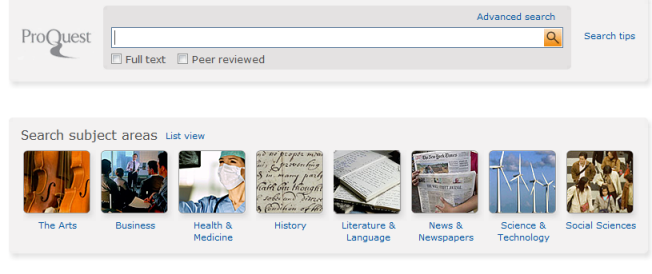
To select either one database or a smaller number of databases, look at the options listed in the "Search subject areas" bar located in the middle of the page. When you move the cursor to a subject area, a hover menu of the databases relevant to that subject appears. If you click on the "Search the..." option, ProQuest will search through all of the databases shown in that subject area. If you wish to use just one database, then click on the title of that database.

How do you find articles in the ProQuest databases?
ProQuest allows users to search for articles using two different search types: Basic or Advanced. For the students' convenience, this section will describe how to use the Basic search. The "Help" icon found in the upper right corner of the ProQuest page provides simple, yet comprehensive instructions for each of the search types.

- To search for articles, type either a phrase or an individual word in the search box and click on the magnifying glass icon. You can combine terms with the Boolean operators "and," "or," and "not;" but if you want to search by a phrase, you must use quotation marks around the phrase.
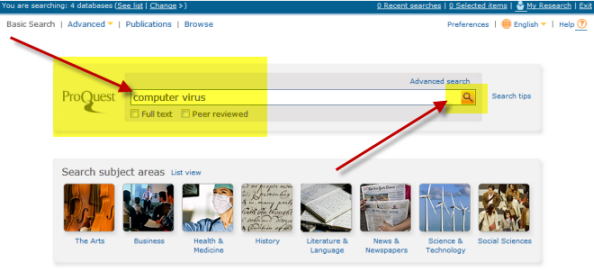
After each search, a screen opens showing the results of that search.

How do you use and read the results of a search?
The Results Page tells you how many articles were found and then lists them. ProQuest's default settings shows 20 articles per screen.
- To view more than the first twenty articles, click on the blue command "Next Page" that is found at the bottom of the Results Page. You may also click on the the blue page numbers to go to a specific page. To view more than twenty articles on a page, click the drop down box next to "Items per page" and choose an option.

Not every article in the ProQuest databases is available in full-text, so the Results list tells you which articles are full-text. Under the title of each article are a series of icons and phrases that tell you how much of that article is available. A "citation" is just the citation. An "abstract" is only a brief description of the article. Only the phrases "full-text" or "full-text-PDF" indicate that the entire article is available. You may also limit results to "full-text" only when searching by clicking the "full-text" box under the search bar.
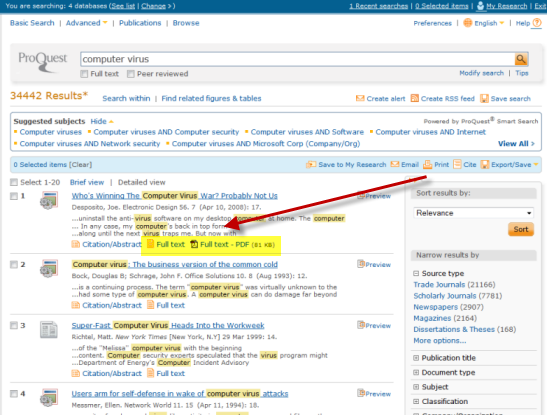
ProQuest does NOT automatically separate the articles into the categories of newspapers, magazines, and journals. You can limit your search to journals by clicking in the box next to the option "Peer-reviewed." ProQuest uses the phrase "Peer-reviewed" to identify what ProQuest identifies as journals.

To help you see if an article might be useful ProQuest uses a hovering tool that shows an abstract of that article and indicates if it is available in full-text. Just to the right of each article on the results page is the option "Preview." When you move the cursor to this option, a small window opens with the citation, an abstract, a list of subjects addressed in the article, and icons indicating if it is, or is not, a full text article. When you move the cursor, this window will automatically close.
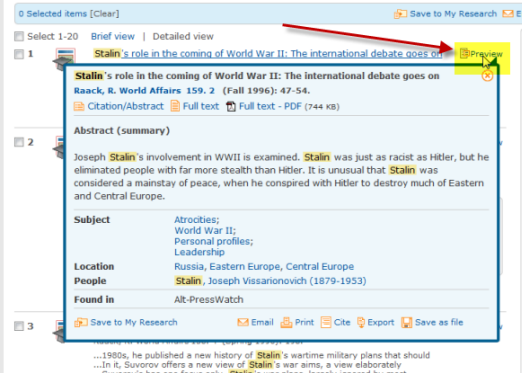
- To read an article, click on the title of the article.
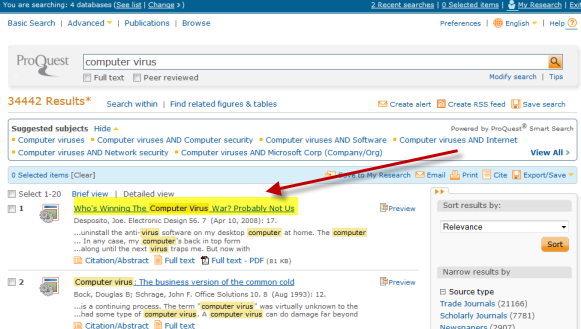
Each article is described with a "Citation." The citation lists all of the information you will need when creating footnotes, a works cited page, or a bibliography. The kinds of information found in a citation include: author's name, title of the article, title of the periodical in which the article is found, date of issue, volume and issue number, and page number(s) of the article. In ProQuest, the full citations are located at the bottom of the article.
To learn how to use this information to make footnotes and a works cited page, you use a "Manual of Style" as assigned in your class.

Each article in ProQuest also offers a "Cite" tool.
- Once the article is displayed, click on "Cite" or the icon next to it and the RefWorks software opens a window which provides citations in each of the major manuals of style.
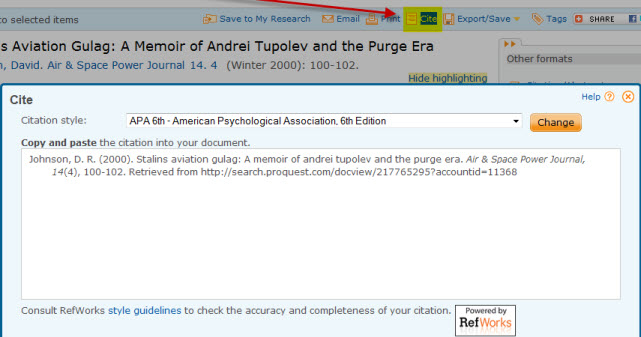
There are learning units that discuss how to use each of the most common "Manuals of Style:" the APA (American Psychological Association) Manual of Style, the Chicago Manual of Style, and the MLA (Modern Language Association) Manual of Style.
How to print, email, or save an article
- If you want to print, email, or save an article, click on the blue commands "Print," "Email," or "Export/Save" that are located in the blue bar found at the top of each article.
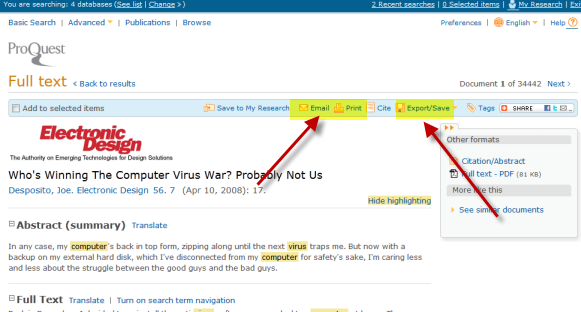
- If the article you want is in "Full-text-PDF" format, click on "Full-text PDF."
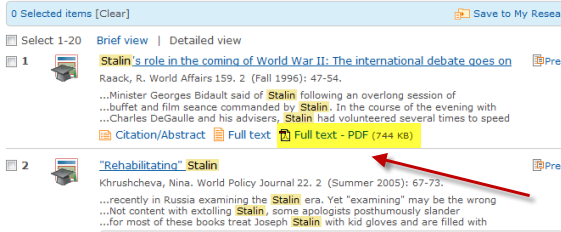
- If a grey screen appears with the message "loading," click on the command "Open in PDF Reader" located at the top left of the grey screen. A window will open asking "Do you want to open or save this file?" Click on "open." An image of the article will then open.
 2-16-12.jpg)
To print or save the PDF you will need to use the print or save icons located on the upper left side of the article.
How do you disconnect from ProQuest?
- When you are finished, move your cursor to the "exit" link, and click on it.
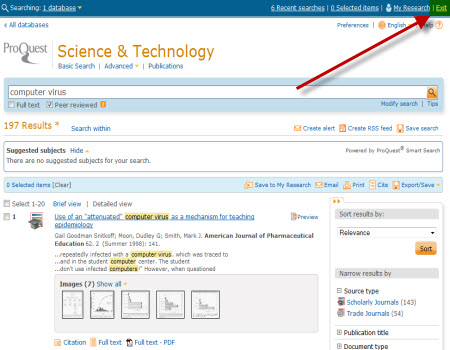
If you have difficulties at any time, ask the Librarian for assistance!
